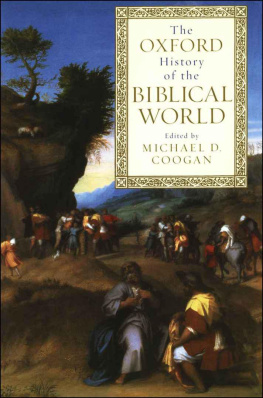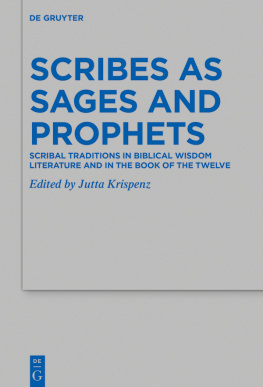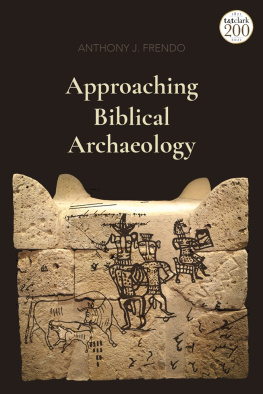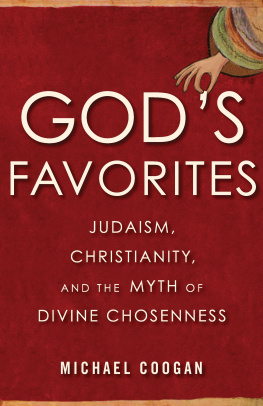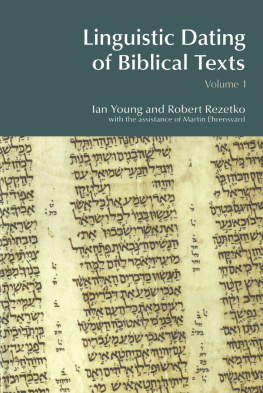The Oxford History
of the Biblical World


The Oxford History
of the Biblical World

Edited by Michael D. Coogan

Frontispiece
A thirteenth-century BCE stela from Ugarit (47 centimeters [18
inches] high) showing the god El seated on his throne, his hand lifted
in blessing toward the worshiper (the king?) to the left. El was the
king of the gods in Ugaritic mythology and is called the kind, the
compassionate in the Ugaritic texts. El is also the name of the patron
deity of Israels ancestors according to the book of Genesis.
(Erich Lessing/Art Resource, NY)
OXPORD
UNIVERSITY PRESS
Oxford New York
Athens Auckland Bangkok Bogot Buenos Aires Calcutta
Cape Town Chennai Dar es Salaam Delhi Florence Hong Kong Istanbul
Karachi Kuala Lumpur Madrid Melbourne Mexico City Mumbai
Nairobi Paris Sao Paulo Shanghai Singapore Taipei Tokyo Toronto Warsaw
and associated companies in
Berlin Ibadan
Copyright 1998 by Oxford University Press
Issued as an Oxford University Press paperback in 2001.
Published by Oxford University Press, Inc.
198 Madison Avenue, New York, New York 10016-4314
Oxford is a registered trademark of Oxford University Press
All rights reserved. No part of this publication may be reproduced,
stored in a retrieval system, or transmitted, in any form or by any means,
electronic, mechanical, photocopying, recording, or otherwise,
without the prior permission of Oxford University Press.
Library of Congress Cataloging-in-Publication Data
The Oxford history of the biblical world/
edited by Michael D. Coogan.
p. cm.
Includes bibliographical references and index.
ISBN 0-19-508707-0 ISBN 0-19-513937-2 (pbk.)
1. BibleHistory of contemporary events.
2. Civilization, Ancient.
3. BibleHistory of Biblical events.
I. Coogan, Michael David.
BS635.2.094 2001
220.95dc21 00-060612
The editor and publisher gratefully acknowledge permission to quote
from the New Revised Standard Version Bible, copyright 1989 by
the Division of Christian Education of the National Council of
Churches of Christ in the U.S.A. Used by permission. All rights
reserved.
2 4 6 8 9 7 5 3 1
Printed in the United States of America on acid-free paper
Contents
PROLOGUE
In the Beginning: The Earliest History
CHAPTER ONE
Before Israel: Syria-Palestine in the Bronze Age
CHAPTER TWO
Bitter Lives: Israel in and out of Egypt
CHAPTER THREE
Forging an Identity: The Emergence of Ancient Israel
CHAPTER FOUR
There Was No King in Israel: The Era of the Judges
CHAPTER FIVE
Kinship and Kingship: The Early Monarchy
CHAPTER SIX
A Land Divided: Judah and Israel from the Death of Solomon to the Fall of Samaria
CHAPTER SEVEN
Into Exile: From the Assyrian Conquest of Israel to the Fall of Babylon
CHAPTER EIGHT
Israel among the Nations: The Persian Period
CHAPTER NINE
Between Alexandria and Antioch: Jews and Judaism in the Hellenistic Period
CHAPTER TEN
Visions of Kingdoms: From Pompey to the First Jewish Revolt
CHAPTER ELEVEN
Churches in Context: The Jesus Movement in the Roman World
EPILOGUE
Transitions and Trajectories: Jews and Christians in the Roman Empire
List of Maps
Preface

The Bible is one of the foundational texts of our culture and of the three major monotheistic traditions, Judaism, Christianity, and Islam. It is a complex documenta set of anthologies, in fact. Thus, fully to understand the Bible requires a knowledge of the contexts in which it was produced, the many cultures of the ancient Near East and the ancient Mediterraneanthe biblical world. For numerous reasons, presenting a history of the biblical world is an ambitious task. The scope of that history is vast, covering at the very least more than two thousand years and spanning three continents. Through archaeological research, new discoveries continue to be made, requiring modifications to earlier views and sometimes reconsideration of interpretive models based on less complete data. Moreover, the study of history itself is in flux. New approaches require, for example, broadening the focus of earlier scholars on the elite, their rulers, and their struggles for power to include the lives of the mostly anonymous ordinary people in the societies of which the elite were only the upper crust. These new data and new perspectives make it possible to take a fresh look at the well-traveled terrain of the biblical world.
The geographical focus of this history is the region variously known as the land of Canaan, Israel, Judea, and Palestine, with appropriate attention to the larger geophysical context and the geopolitical entities that over millennia were the matrix for biblical Israel and its successors, the Jewish, Christian, and Muslim communities. When to begin and end a history of the biblical world is more difficult to decide. The Bible itself begins with creation but dates it aeons later than modern scientific understanding of the origins of the universe allows. As the early chapters of this book will show, it is impossible to correlate with any certainty the events described in the first books of the Bible with known historical realities. Yet it is appropriate to set the core of our history into a larger context, as biblical tradition itself does, for there are demonstrable continuities between the earliest civilizations of the ancient Near East and ancient Israel, early Judaism, and early Christianity. The book thus begins with a sketch of the prehistory of the region.
When to end is also problematic. Surveys of the history of ancient Israel sometimes conclude with the revolt of the Maccabees in the mid-first century BCE , which corresponds to the dates for the latest books of the Hebrew Bible (the Jewish scriptures); or the Roman general Pompeys capture of Jerusalem in 63 BCE ; or the destruction of the Second Temple in Jerusalem in 70 CE ; or the end of the Second Jewish Revolt against the Romans in 135 CE . This last is also a frequent terminus for surveys of Christian origins, since the scholarly consensus is that the latest books of the New Testament had been completed by then.
Our approach, however, emphasizes continuities and trajectories. The formation of a canon, a collection of writings defined as scripture, was in fact not a discrete event but part of a process that began before any part of the Bible was written and continued after religious authorities in Judaism and in different branches of Christianity limited the contents of their respective canons. The communities that shaped the Bible became, as they developed, communities shaped by the BiblePeople of the Book, as the Quran puts it. And because this connection to the Bible is not only Jewish and Christian but also Muslim, our history concludes by briefly considering developments in the first few centuries of Judaism and Christianity and the beginning of Islam.
Next page
